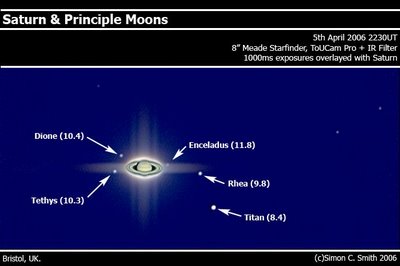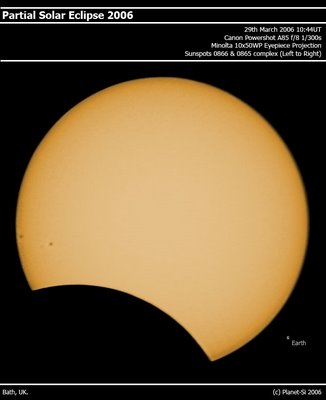Full 8.3d Lunar Mosaic

This is a mosaic taken on the same night as the Ariadaeus close up - Newtonain prime with my trusty ToUCam Pro. 6 avi strips were captured and split/processed into a total of 19 image sections that were registered and overlayed onto each other in iMerge.
Polar alignment was not perfect so slight image rotation crept in across the strips causing an annoying blur on alignment. I should really have trimmed the frames down to have minimal overlap to reduce the iMerge induced overlap effect but it's not as good image of this phase of the Moon as I've captured before so I won't spend my time doing it now.
I rather like the rays around Bessel, Proclus, & Messier in the Mare Serenitatis, Mare Crisium, & Mare Fecunditatis respectively. The differing contrasts of Mare materials on the boundary of Serentatis & Tranquilitatis are quite evident as is the interesting contrast edge around Madler on the border of Mare Nectaris and Sinus Asperitatis. The last large scale feature I want to mention is the wonderfully named Palus Somni - the Marsh of Sleep. It sounds like something straight out of Lord of the Rings! The rays from Proclus on the western border of Mare Crisium beautifully frame is against Mare Tranquilitatis.
The prominent features on the limb start with Vallis Alpes in the north, down though the magnificently lit Cassini, to the pair Aristillus and Autolycus by the gap between the massive Montes Caucasus & Apenninus. Note the very bright peak of Mons Piton on the far side of the terminator towering 2.3km into the light of the rising sun.
Moving down is a region I previously imaged here - I do not know the name of the "scraped" formation between Mare Vaporum and Sinus Medii though, but it is so prominent during this lunar phase that it should really have a name!
The next prominent crater chain starts with Hipparchus and Albategnius just to the south of Sinus Medii (with its bright central peak and wall-busting resident crater Klein). I feel these are often overlooked by their larger neighbours Ptolemaeus, Alphonsus, and Arzachel, but during this phase of the Lunar cycle they are still hidden on the other side of the terminator so they take the lime light for once!
Moving south another 20 degrees brings us to Werner and Aliacensis bordering the spectacular crater Walter, with its western walls rising out for the terminators darkness in a delicate ring of peaks. Then we enter the Southern Zone of the Lunar surface and its multitude of overlapping craters and chaotic terrain.
I was going to post a link to the full size original, but blogger does not seem to let me upload such a large image (2206x2206 image) .. ah well, maybe I should get myself a proper website :)
Saturn and Family
 This is the last of the days batch to process - Saturn. I captured 6 avi's and selected the best 75% to create this image. The Cassini division is quite pronounced as well as some of the subtle banding in Saturns cloud tops.
This is the last of the days batch to process - Saturn. I captured 6 avi's and selected the best 75% to create this image. The Cassini division is quite pronounced as well as some of the subtle banding in Saturns cloud tops.

I also took some long exposure images without the barlow lens (1000ms each) and stacked these to reveal the moons of Saturn. Overlaying the original Saturn image on to the long exposure reveals their positions well. Note the long exposure has caused bleeding of Saturn into a cross - this actually just obscured Mimas which is very close to the ring system in the bottom left round from Tethys.
Seas, lakes, and bays ... Continued ...
It turns out my good friend and fellow astronomer Jan Timmermans was also imaging this exact area of the Lunar surface just four and a half hours earlier. The time difference was just sufficient enough to capture the march of the Lunar dawn shadows across the surface, so we embarked on an international collaboration and came up with a nice animation of the two frames. Pop over to his website to see the result at:
http://www.madpc.net/~firmament/animations.html
Scroll down to April 5th 2006. Do check out the rest of Jans site - you're sure to find some more items of interest in there!
Seas, lakes, and bays ...
 I finally got my 8" Starfinder out its moving-house crate and put it to use. After an hours recollimation from the rigours of moving I took a set of high resolution images and created this mosaic of the Heart of the moon - Sinus Medii, the Central Bay. If you were standing on the Lunar surface there the Earth would perpetually hang directly over your head ...
I finally got my 8" Starfinder out its moving-house crate and put it to use. After an hours recollimation from the rigours of moving I took a set of high resolution images and created this mosaic of the Heart of the moon - Sinus Medii, the Central Bay. If you were standing on the Lunar surface there the Earth would perpetually hang directly over your head ...
I'm pleased with the level of detail I captured in the Sinuous Rilles around Triesnecker (crater in the bottom left) and the change in contrast (and I guess composition) where Mare Tranquilitatis (bottom right) meets Mare Serenitatis (top right) around the large crater Plinius. Note also the collection of lakes (Lacus) in the upper center of the image - it doesn't take all that much to imaging they are dried up lake beds!
The Partial Solar Eclipse of 2006
 Well, the gods were smiling down on me for my second eclipse again - the clouds cleared just as maximum partial occurred allowing me to snap the image below. It did the same for the total solar eclipse in Cornwall a few years ago - magical. After watching this I kind of regretted not traveling to see it ... Ah well, considering the circumstances if was not going to happen anyway.
Well, the gods were smiling down on me for my second eclipse again - the clouds cleared just as maximum partial occurred allowing me to snap the image below. It did the same for the total solar eclipse in Cornwall a few years ago - magical. After watching this I kind of regretted not traveling to see it ... Ah well, considering the circumstances if was not going to happen anyway.
Taking this image did entail sneaking out the back into the carpark at work, but I think it paid off! It was taken through my filtered binoculars using a Canon A85 Powershot digital camera. Because of the amount of glass between source and CCD I broke the stacked image of 6 into RGB, and used only the green channel. Processing was done in a combination of K3CCD, Registax, and PixInsightLE. Registering the images proved difficult due to rotation between frames (I was holding this by hand). I altered the hue of the B/W image for a more aesthetic result. I'm rather pleased that the sunspot clusters were visible in the processed image.
Roll on 2008 - I might just have to brave the midges in Greenland ...
Lunar Mosaic
 Here is the first image from our new house - a five and a half day old moon. It was more as a test session for finding a good location in the garden for the (soon to be built) observatory, but it came out rather well so I thought I'd post it up!
Here is the first image from our new house - a five and a half day old moon. It was more as a test session for finding a good location in the garden for the (soon to be built) observatory, but it came out rather well so I thought I'd post it up!
Details: Taken at prime focus through my Skywatcher ED80 using a ToUCam Pro. It's a mosaic of 4 overlapping images processed in a combination of Registax and PixInsightLE.
I'm not 100% happy with the contrast of the result, but I've never been quite able to reproduce the tonal quality of the Moon as seen visually - mostly due to the dynamic range of the subject. It would be nice to get close though! Still it is far better than my last attempt of a 5 day moon!






